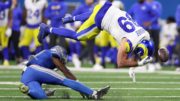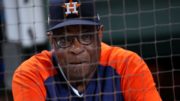Victor Wembanyama must be getting tired of spearheading simultaneous counter-revolutions. One is France’s Golden Generation fortifying itself just in time for the 2024 Paris Olympics. But within the confines of Gregg Popovich’s San Antonio Spurs, Wembanyama’s on pace to emerge as the league’s preeminent defensive anchor during the most prosperous offensive age in league history.
Take last night for instance. During the first quarter of San Antonio’s 115-114 win over Phoenix, Wembanyama’s flyswatter returned a Grayson Allen triple back to him. Then, in the final frame, his fourth block was a mid-flight deflection of Jordan Goodwin’s 27-footer from above the break. For the night, Wembanyama redirected air traffic four times. On the Suns’ final possession, Kevin Durant released his shot off for the win, but a contest from Wemby and Keldon Johnson’s outstretched arms rattled him just enough to force the miss. Durant taught Wembanyama a lesson earlier in the contest, but the Spurs rookie laughed last.
As a stretchy, raw, 7-foot-3 teenager, Wembanyama is a defensive guillotine, flashing the capacity to behead Gilded Age offenses that have benefitted from rule changes and modern floor spacing to generate opulent numbers beyond the arc. San Antonio is currently 24th in defensive rating, but his impact is being felt already. Wemby-less Spurs lineups are allowing 128.4 points per 100 possessions, lapping the Utah Jazz’s league-worst defensive rating of 119.8. With Wembanyama on the floor, San Antonio’s defensive rating improves to 104.8, according to Basketball Reference, which would be higher than Golden State’s seventh-best defense if extrapolated to 48 minutes.
While the genesis of most phenoms like LeBron James and Kareem Abdul-Jabbar have been some element of their offensive prowess, Wembanyama’s was his defense at the 2021 FIBA Under-19 World Cup. In that tournament, 19-year-old Chet Holmgren was already being anticipated as the next great shot blocker and lived up to his rep by sending back 20 shots in seven appearances. However, while the U.S. won gold, Holmgren got shown up by the then-17-year-old French teenager who crystallized his status as the defensive unicorn, by swatting a tournament-record 40 shots in seven contests.
Both are the forerunners for a generation of bigs who are uniquely suited to defend the perimeter and the post, but Wembanyama cemented himself as the defensive phenom of the century. Wembanyama has the potential to be the ideal defender for the modern age.
A decade ago, Anthony Davis was supposed to be that dude after pushing Ctrl+Alt+Delete on an NCAA freshman-record 186 shots in his lone season at Kentucky. We’ve been wrong before. The consensus after Karl Anthony-Towns’ freshman year was that he was a next-level defensive scarecrow after leading the nation in defensive ratings and crushing four shots per 40 minutes. The bar is set even higher for Wembanyama. He is still a work in progress, but there are future Defensive Players of the Year honors already being set aside for him.
Wembanyama is basketball’s evolutionary response to aristocratic offenses facing malnourished defenses. Nature presented a sideline general in Popovich who has openly discussed his disdain for the 3-point shot with the ultimate weapon to give the rest of the league a comeuppance.
“I still hate it. I’ll never embrace it,” Popovich told the press in December 2015. “I don’t think it’s basketball. I think it’s kind of like a circus sort of thing.”
His 2014 Spurs were the last NBA champion to make fewer than 10 triples a night. Even amid the surge in long-distance shooting, the Spurs frustrated the KD-Steph Warriors in 2017 while attempting the fifth-fewest three-pointers in the league.
San Antonio’s decline amid the Gilded Age for offenses
The emergence of most revolutionary leaders hinges on two factors. Do they possess distinctive traits that empower their rise and does the need for their traits exist?
Coming off the heels of the 2015 Golden State Warriors’ “jump shooting title” and their 73-9 campaign, Daryl Morey’s and Mark D’Antoni’s Frankenstein Rockets lit the fuse on the perimeter offense’s takeover of the game by jacking up 40 triples a night. Until that point, no team had averaged more than 33 attempts.
Modern offensive basketball is now predicated on efficient outside shooting and taking advantage of spread-out defenses spacing to slice through driving lanes with the intention of either finishing in the paint, kicking out to shooters, or getting fouled. Wembanyama’s lateral agility and absurd length allow him to swallow up anyone who tries either in his vicinity. He can alter the trajectory of a triple from drop coverage, switch onto the roll man and close out on shooters, and blot out their sun like Mr. Burns’ giant mechanical shade.
Meanwhile, Popovich started looking like the game had passed him by. From 1999 to 2018, Popovich’s Spurs defenses were top-5 in points allowed per 100 possessions, and six times they were the league’s stingiest defense. Meanwhile last season, the Spurs were the NBA’s worst defensive team and their league-wide offensive rating of 114.8 points per 100 possessions eclipsed the previous NBA record set in 2021 by nearly three points. Coupled with the fact that the eight most explosive offensive seasons in league history have all occurred since the 2016-17 campaign, you couldn’t have asked for better conditions for a counter-revolutionary player and an iconoclastic coach.
Enter Wembanyama
Scheming an effective defense of the three-point arc has been of growing importance for a coaching staff. San Antonio’s guillotine is not only a future HoF GTFOH rim defender, but a bloodhound on the perimeter. In an era where teams hunt mismatches through switches, that flexibility is vital. If anyone ever wonders why Draymond Green is a future Hall of Famer, just keep in mind that he was a precursor to the switchable jumbo bigs who are suddenly proliferating. In the last decade, Green has burnished his reputation as the premier defensive free safety by patrolling the paint as a small ball 5 and playing physical perimeter defense well enough to redirect a league-high 105 3-pointers since 2013.
If the last decade was about the space created by otherworldly shooters, Wembanyama’s radius is a space killer. Wembanyama’s length allows him to bisect large sections of the floor. In their preseason tune-up against the Warriors, Wemby guarded like a Joan of defending the Arc, obliterating Andrew Wiggins and Klay Thompson’s shots from downtown at their apex. And good luck driving by him once he closes out, as Wiggins discovered firsthand.
Popovich has a penchant for landing the league’s eminent two-way forces. Tim Duncan was a three-time national Defensive Player of the Year at Wake Forest before earning an NBA-record 15 All-Defense Teams en route to five titles. David Robinson’s single-season record of 207 blocks during his senior season at Navy still stands as the official benchmark. Those two stand out as the two of the most prominent defensive two-way big men in college basketball. Then, he extended the life of those Spurs by identifying and trading for the rights to future Defensive Player of the Year Kawhi Leonard on draft day.
Will Wembanyama ever make a run at LeBron’s scoring record or surpass Kareem? Even with his eight-foot wingspan, Wembanyama probably won’t reach those scoring heights. Becoming the first player to 4,000 career blocks, and joining Olajuwon as the only 7-footers to pluck enough steals to rank in the top 10 all-time of that stat is the likelier head in the clouds projections of Wembanyama. Wembanyama is better served chasing Olajuwon as a modern two-way leviathan and assisting Pop in bringing the Spurs’ defense back to the forefront.
Olajuwon’s legacy is not just the Dream Shake, but erasing more shots than anyone in league history. In the post-merger NBA, Olajuwon is still considered the consummate model of a 7-foot gatekeeper. He too was a defensive phenom. During his sophomore and junior seasons at Houston, “The Dream” registered 207 unofficial blocks, before the stat was officially recorded by the NCAA which would match Robinson’s record.
Offenses pushing the bulk of their offensive manufacturing further outside has depressed the rate of blocks in the modern NBA, but Wembanyama could be the exception. The block Olajuwon is most synonymous with is his rejection of John Stark’s desperation trey to end the ‘94 NBA Finals. Wembanyama might have more plays like that than anyone in league history.
The French guillotine may not drop this season or next. Wembanyama is still figuring out how to work the levers on all aspects of his game. But for advocates of tough defense, this could be the genesis of a Spurs revival. At the peak of the Gilded Offensive Age, San Antonio’s defensive counter revolución is beginning.
Follow DJ Dunson on X: @cerebralsportex
Original source here
#Victor #Wembanyama #lead #Gregg #Popovichs #defensive #counterrevolution





